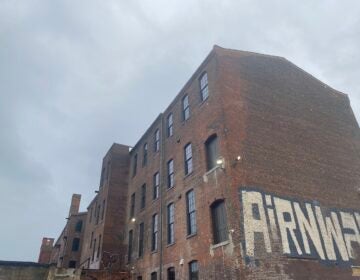DAGchair: Meeting of May 3, 2012
This is an anecdotal account of the last meeting written by the chair, to be published each month. These notes are intended to update people who were not able to attend the meeting. They are not intended to be minutes. If anyone has items to add or correct, please contact me. It is also intended to be a heads up about current and upcoming DAG issues. As always, tips, gossip and ideas are welcome. Since these notes are coming out at the beginning of June, some recent developments regarding the land bank are included.
GENERAL DISCUSSION
The DAG Postcard Project is moving along, due to the hard work of Laura Spina and her committee. In honor of DAG’s tenth anniversary, it will feature an exhibit at the Center for Architecture beginning July 30. One part of the exhibit will feature buildings completed in 2002 or after, and will invite viewers to vote on their favorites. The rest of the exhibit will feature Philadelphia buildings going back to 1682 that embody principles of good design.
Penn Praxis will be working with Philadelphia Parks and Recreation to create an action plan for the Parkway and identify projects that can be individually funded and completed. Civic engagement meetings will take place in July; keep an eye on PlanPhilly for dates.
Regina Gorzkowska-Rossi is working on creating a Port Richmond Historic Village to recognize the Polish, Irish, German and Lithuanian immigrant contributions to the neighborhood. For more information, contact Regina at 215-563-6669.
LAND BANK COMMITTEE
The Land Bank Committee is still active. George Claflen and I attended a meeting with the Building Industry Association (BIA). I have attended meetings with a coalition of interested groups convened by the Philadelphia Association of CDCs (PACDC), and we met with Councilwoman Quinones-Sanchez and her staff. We discussed proposed amendments to the legislation including the following:
· The governance board of the land bank would include designated positions that include some with professional expertise and some representatives of community organizations.
· Pricing of land for disposition could be modified based on benefits to the community, to which DAG added “and for innovation in design and sustainability”.
· The role of Council would be transparent, predictable and limited to the early stages of the project.
With input from the DAG Steering Committee, I let the PACDC group know that DAG would not support, and might actively work against, the land bank legislation if the last item could not be resolved. The Steering Committee was firm in not wanting to memorialize the Council prerogative of derailing a land disposition at any point along the way. We are joined in this position by the BIA and the Philadelphia Association of Realtors.
PACDC has been running community meetings to gain support for the land bank proposal, and the results have been somewhat discouraging for two reasons. First, most attendees were there to press for access to a specific piece of land and not to address the whole of the vacant land issue in the city. Second, there was enormous cynicism about the possibility of a new governmental agency making any difference, and not being inefficient at best or corrupt at worst. More meetings are planned, by Project HOME and others.
The land bank legislation will not be introduced in City Council before September, by which time it seems likely that the state enabling legislation will pass the House and Senate and be signed into law by the governor. As most of you know, Council is preoccupied with the city budget and the Actual Value Initiative property tax changes, and there is very little possibility of the land bank getting their attention this spring.
Many people, including me, are convinced that a land bank is the best way to begin to solve the many problems brought on by vacant land in Philadelphia. Vacant land was cited in the 2010 Next Great City poll as the number one concern of its many member organizations, and it is a problem that is only getting worse. The Mayor has made a huge contribution with the Front Door initiative and the creation of a land bank would not be possible without that step. But a land bank is needed to foster quality development of both city owned properties and, in the near future, privately held blighted properties.
I’ll keep you posted in DAGchair articles over the summer. Vacant land policy is not an issue to arouse much excitement during the season of cold beer and flip flops, but I hope you will stay interested and involved.
THE RIDGE FLATS PROJECT BY ONION FLATS
Tim McDonald presented his firm’s project for the Philadelphia Redevelopment Authority (PRA) site at the former Rivage nightclub on Kelly Drive. As was the case the Carpenter Square project we saw in March, PRA awarded the land to Onion Flats based the merits of the project, not the highest bid. This represents a welcome culture shift for the agency during this administration. The presentation is on our website at http://www.designadvocacy.org/meeting/ridge-flats
We will want to keep tabs on Ridge Flats for a couple of reasons. First, it will be a certified “Passive House” building with zero net energy use. This is a first for Philadelphia and a big jump in scale for Onion Flats. Tim said, “If you want to make a difference, everything has to do with scale”. Second, in order to achieve zero net energy use, the building is thought of as a coat. (As my Canadian friends say, there is no such thing as bad weather, just inappropriate clothing choices.) To get the required tight building envelope, most of the construction will be in Tim’s modular factory. This is sure to raise the interest of the Philadelphia building trades.
As always, Tim had provocative and irreverent comments. On urban life: You can’t get away from people, so how do you deal with them? On design: If something functions only one way (like a double loaded corridor), don’t do it; make it do at least three things. He referred to the Dwellification (as in the magazine) of modular, with $800/sf suburban houses. And on the proposed land bank: It’s about excellence. Period. End of story.
INGA SAFFRON
Our June 7 meeting features Inga talking about her Loeb Fellowship year, from Cambridge to Vancouver to Mumbai.
ALOHA TUESDAY?
It has been suggested by a couple of esteemed and serious colleagues that we should do more drinking together now that summer is upon us. Wednesday Sips in Center City has turned into a madhouse; Thursday starts the weekend for some lucky people; Monday is for resting up from the weekend. How about scheduling some Aloha Tuesdays at a Center City bar, maybe one each in June, July and August?
As always, thanks to you all for your interest, time and energy. Aloha.
Kiki Bolender
DAG Chair
WHYY is your source for fact-based, in-depth journalism and information. As a nonprofit organization, we rely on financial support from readers like you. Please give today.






